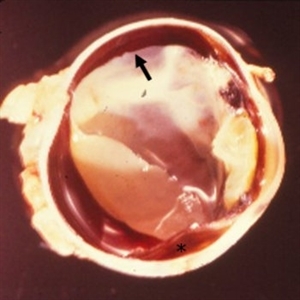-
 Nongranulomatous Uveitis
Nongranulomatous Uveitis
May 18 2020 by McGill University Health Centre
Nongranulomatous uveitis is a group of diseases often related to systemic autoimmune diseases such as arthritis. In this enucleation specimen, the choroid is diffusely thickened (arrow) and a choroidal detachment is present (*). The retina is opaque and the lens is cataractous.
Condition/keywords: uveitis
-
 Nongranulomatous Uveitis
Nongranulomatous Uveitis
May 18 2020 by McGill University Health Centre
Nongranulomatous uveitis is a group of diseases often related to systemic autoimmune diseases such as arthritis. This image shows a thickened uveal track (arrows) and a complete, long-standing retinal detachment (*). The lens is cataractous and the iris, ciliary body, and parts of the retina are attached to it. A scleral buckle is present (arrowheads).
Condition/keywords: uveitis
-
 Intermediate Uveitis
Intermediate Uveitis
May 18 2020 by McGill University Health Centre
This enucleation specimen shows: “snowballs” or localized inflammatory foci (arrow); and a “snow bank” or inflammation at the ora serrata, the anterior-most limit of the retina. These are caused by a reaction to the subjacent uveitis (arrowhead).
Condition/keywords: intermediate uveitis
-
 Diffuse Uveitis
Diffuse Uveitis
May 18 2020 by McGill University Health Centre
In this enucleation specimen, the uveal tract is completely replaced by purulent material (*). There is a subretinal hemorrhage underlying the detached retina and fibrous material in the vitreous cavity (arrowhead). The lens is cataractous and is surrounded by fibrinoid membranes (arrow).
Condition/keywords: uveitis
-
 Granulomatous Uveitis
Granulomatous Uveitis
May 18 2020 by McGill University Health Centre
Granulomatous uveitis is found in many inflammatory diseases, and is generally characterized by a predominant histiocytic infiltrate forming a “wall” (granuloma) around a pathogen or foreign body. This is an example of granulomatous uveitis. The eye is aphakic; the uveal track is thickened; and a granuloma is present and attached to the endothelium of the cornea (arrow). The anterior chamber is filled with a hazy material (arrowhead). The vitreous is fibrotic and tractional bands are also present (*).
Condition/keywords: granulomatous uveitis
-
 Lens-Induced Uveitis
Lens-Induced Uveitis
May 18 2020 by McGill University Health Centre
In lens-induced uveitis, lens protein in the anterior chamber causes a zonal granulomatous response, which occurs usually 1 day to 3 weeks after capsule rupture. This may be associated with sympathetic ophthalmia. This enucleation specimen shows an indented cornea, accompanied by complete hypopyon occupying the anterior chamber with intense vitreitis. Note that the translucent vitreous has become whitish, and the lens surface is irregular with decoloration of the peripheral areas (arrows).
Condition/keywords: uveitis
-
 Subretinal Fibrosis and Uveitis Syndrome
Subretinal Fibrosis and Uveitis Syndrome
May 18 2020 by McGill University Health Centre
Uveitis syndrome is a rare posterior uveitis that usually begins as a multifocal choroiditis and then progresses to subretinal fibrosis. Recurrences are not uncommon and the visual prognosis is generally poor. In this enucleation specimen, a thickened choroid is clearly observed (arrow). The retina is detached and a fibrovascular subretinal membrane is present (arrowhead).
Condition/keywords: subretinal fibrosis, uveitis

A project from the American Society of Retina Specialists